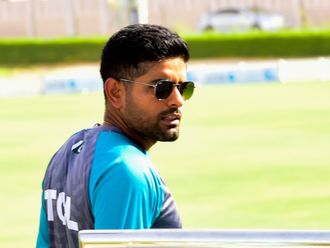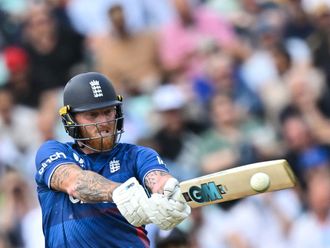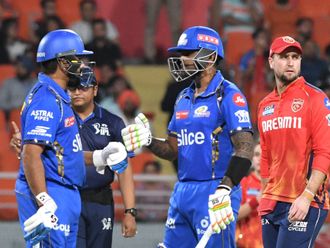I was one of the lucky ones to be part of a winning ICC Cricket World Cup squad, when hardly anybody knew who Inzamam-ul-Haq was. While the sweet memory of that Crystal Ball at Melbourne Cricket Ground in 1992 is still fresh in my mind, I really feel sorry for greats like Sir Richard Hadlee, Zaheer Abbas, Abdul Qadir and Dennis Lillee, who quit the game without winning a World Cup.
Here’s my team of players who deserved to be part of a winning side but unfortunately couldn’t do so.
1. Saeed Anwar: Before openers like Matthew Hayden and Virender Sehwag took the world by storm, if one had to pick an opener in one-day cricket, Anwar was the man for the slot. There weren’t many players during his playing days who batted at a strike-rate of 80-plus with so much elegance and power. He came agonisingly close to the title in 1999, but we lost to Australia in the final at Lord’s despite the fact that he was in ominous form and had smashed a century against New Zealand in the semi-finals.
2. Sourav Ganguly: Lady luck didn’t smile on Sourav when, in 2003, India lost to Australia in the final. I feel India progressed in one-day cricket during the captaincy of this gifted cricketer from Bengal. He was one of those cricketers who played beautifully on the off-side of the wicket. Most of the time he scored, India won.
3. Brian Lara: The man who has a fan following throughout the world. A cricketer who will be pencilled first whenever a world XI is made — be it limited overs or Test cricket. I haven’t seen a better left-hander than Brian, who without doubt was a match-winner. The best thing about him was when the West Indies chased in one-day cricket. For him to score at an average of seven or eight runs per over was not a herculean task against any type of bowling. I haven’t seen a better batsman who could play shots to all parts of the field. I think 1996 was his best chance to win the event but the West Indies lost to Australia from a winning position in the semi-final.
4. Jacques Kallis: His record speaks for itself. Perhaps the only all-rounder who could walk into any playing XI either as a specialist batsman or a specialist bowler. To me, in one-day cricket, only Sachin Tendulkar comes ahead of Jacques. I’ve heard a lot about Sir Garfield Sobers, who used to be good at both bowling and batting, but Jacques is for sure on par with him. He was good at reversing the old ball, but I still remember during one of the ODIs against us, he took the new ball and bowled at over 145kph and made our batsmen struggle.
5. Martin Crowe: One of my all-time favourite cricketers, whom I followed a lot. I haven’t come across many cricketers who were good against both spin and fast bowlers like Martin. I have seen lots of great batsman, but the batting technique of Martin was far better than most of them. His magnificent form saw New Zealand qualify for the semi-final in 1992. He deserved to win the World Cup but we clicked in time and ended New Zealand’s brilliant run.
6. Rahul Dravid: The cornerstone of India batting and appropriately known as ‘the Wall’, Rahul carried the India team with his wide range of stroke-selection and finished with nearly 11,000 ODI runs. Along with Sourav, Sachin and Virender, he formed one of the strongest batting line-ups. Unfortunately, the foursome couldn’t win the World Cup together.
7. Ian Botham: An aggressive all-rounder who played in an era when one-day cricket was not that aggressive and most nations were concentrating on Test cricket. Before Jacques, he was the all-rounder who batted as well as he bowled and supplemented this with his bucket hands, which earned him great catches in the slips. We were lucky to dismiss him early in the 1992 final because he could have easily taken the game away from us with his brutal batting, but his best chance was potentially in 1983, when England had some of the best cricketers.
8. Anil Kumble: A miser of a leg-spinner, who didn’t like to be hit for runs. Anil was not a big spinner of the cricket ball, but kept batsmen thinking with his superb line and length. Whenever he got favorable turfs, he was there to turn the tables on opponents. He was probably the only spinner who was not shy of showing aggression like the fast bowlers.
9. Waqar Younis: Great bowler with bad luck as he had to fly back home from Australia in 1992 due to a back injury. I still remember when we landed at Islamabad airport after winning the World Cup, Waqar was there on the truck, crying for not being part of the winning World Cup squad. Who could forget his pairing with Wasim Akram that tormented batsmen with their toe-crushing yorkers with over 150kph. We let him and the country down in the final at Lord’s in 1999, while Sachin undid Pakistan in Mohali in 2011 when Waqar was the coach.
10. Allan Donald: He was quite pacey when I first batted against him in 1992. At that time he didn’t know how to reverse swing, but learnt the art quickly. South Africa owe a lot of their early successes to Allan, who regularly destroyed the top order. The rain-rule in 1992, the drop of Steve Waugh’s and the tied match in 1999 denied him the chance to hold the silverware.
11. Curtly Ambrose: To play international cricket for such a long period of time with such a height is something that is a big achievement. He bowled at such a good line and length and moved the ball both ways, making life difficult for batsmen anywhere around the world. He filled the void left by Michael Holding, Malcolm Marshall and Andy Roberts while pairing with Courtney Walsh.
12. Jonty Rhodes: The only cricketer in history who could make it to any team purely as a fielder. Whenever we played against him, I used to note down 30-40 against his name because of his fielding. I still smile when I recall his ‘flying’ run out of mine in the 1992 World Cup. He was such a brilliant athlete that he used to change the attitude of an entire team through his electrifying fielding.
— 2015 © ICC Development (International) Limited










